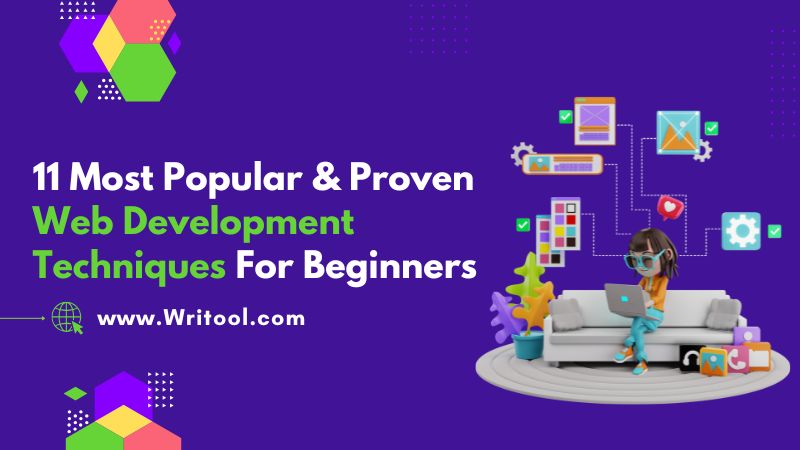When you’re starting your journey in web development, knowing the right web development techniques can make a significant difference. Web development is a constantly evolving field, and it’s crucial to stay updated on the most effective practices that can help you create stunning, functional websites.
Whether you’re a beginner looking to improve your skills or explore new techniques, mastering web development tips and techniques is essential to staying ahead in this competitive industry. These techniques help create robust websites and ensure they are user-friendly, fast, and scalable.
In this blog, we will explore 11 popular and proven web development techniques that every beginner should learn to build strong foundations in web development. Whether you are working on your first project or looking to upgrade your current skills, these techniques will equip you with the tools you need to succeed.
What Is Web Development?
Web development involves creating and managing websites, ranging from basic static pages to intricate dynamic web applications. Web development involves tasks like designing the website layout, writing code, integrating databases, and ensuring the site functions smoothly across different devices and browsers. There are three main types of web development: front-end (client-side), back-end (server-side), and full-stack (both). Each aspect plays a crucial role in delivering a seamless and interactive user experience, making web development essential in creating modern, functional websites.
Also Read:- Best Data Analysis Tools
7 Best Languages For Web Development In 2025
When it comes to web development, choosing the right programming language is key to building efficient and functional websites. Here are seven of the best web development languages that every developer should consider:-
HTML (HyperText Markup Language)
HTML is the backbone of web pages. It organizes content such as text, images, and links into a structured format.
CSS (Cascading Style Sheets)
CSS is responsible for the visual design of web pages. It controls layout, color schemes, fonts, and responsiveness, ensuring that a website looks appealing and functions well on all devices.
JavaScript
JavaScript is a versatile programming language that enhances user engagement by adding interactivity to websites. It powers dynamic features like animations, interactive maps, and form validations.
Python
Python’s simplicity and readability make it a perfect choice for beginners. It’s widely used in back-end development and is popular for web frameworks like Django and Flask.
Ruby
Ruby, particularly with the Ruby on Rails framework, is known for rapid development and ease of use. It’s ideal for building scalable web applications and has a strong community for support.
PHP
PHP is a server-side scripting language for developing dynamic and interactive web pages. It’s widely used in back-end development and powers popular content management systems like WordPress.
SQL (Structured Query Language)
SQL is essential for interacting with databases. It can be used to query, insert, update, and delete data, making it indispensable for web developers who work with databases.
11 Proven Web Development Techniques For Beginners
Starting your journey in web development can be both exciting and overwhelming, with countless techniques and tools to explore. To help you build a strong foundation, here are 11 proven web development tips & techniques designed specifically for beginners:-
1. Responsive Design for Mobile and Desktop Compatibility
Responsive design is one of the most crucial web development techniques to understand, especially for beginners. With more users accessing websites from mobile devices than ever before, ensuring that your website is mobile-friendly is non-negotiable. Responsive design allows websites to adapt to different screen sizes, ensuring that your site looks great on desktops, tablets, and smartphones. By using CSS media queries and flexible grid layouts, you can build websites that seamlessly adjust to varying screen sizes without compromising on performance.
2. Clean and Efficient Code
One fundamental web development technique every beginner must embrace is writing clean and efficient code. Clean code not only makes it easier to troubleshoot and maintain your website but also improves its performance and user experience. Efficient coding practices include avoiding unnecessary repetition, using proper naming conventions, and following the DRY (Don’t Repeat Yourself) principle. By writing clean code, you ensure that your website is easier to debug, faster to load, and more scalable for future updates.
3. Using Frameworks to Simplify Development
Frameworks are another essential web development technique that can significantly speed up the development process for beginners. Frameworks such as React, Angular, or Vue.js provide pre-built components and templates that save time and effort. Using a framework allows you to concentrate on your project’s unique elements without needing to start from scratch. These frameworks also come with built-in features like routing, state management, and data binding, which can enhance your websites’ functionality with minimal effort.
4. Version Control with Git
Version control is a must-learn web development technique for beginners. Git, a version control system, enables developers to monitor code changes, collaborate seamlessly, and roll back to earlier versions when needed. GitHub or Bitbucket provides remote repositories where developers can store and manage their code. With version control, you can easily manage updates, troubleshoot bugs, and work collaboratively with other developers on larger projects.
5. Search Engine Optimization (SEO) Basics
Search Engine Optimization (SEO) is an important web development technique to help ensure your website ranks well on search engines like Google. By incorporating SEO best practices such as optimizing page titles, meta descriptions, and using appropriate keywords, you increase the chances of your website being discovered by a wider audience. Additionally, implementing clean and semantic HTML tags, optimizing images, and improving site speed are key SEO factors that can boost your website’s performance.
6. Mastering JavaScript for Interactive Websites
JavaScript is one of the core web development techniques you’ll need to master as a beginner. It allows you to add interactive elements like forms, animations, and dynamic content to your websites. By learning JavaScript, you gain the ability to build more engaging and user-friendly websites. Beginners can start with basic functions and gradually progress to more advanced concepts like asynchronous programming, DOM manipulation, and APIs.
7. Web Accessibility (a11y) Standards
Web accessibility ensures that websites are usable by all people, including those with disabilities. Implementing web accessibility standards (a11y) is an essential web development technique for creating inclusive websites. It includes practices such as adding alt text for images, providing keyboard navigation options, and ensuring color contrast is sufficient for those with visual impairments. By learning and applying web accessibility guidelines, you make your website accessible to a broader audience and comply with legal requirements in many regions.
8. Content Management Systems (CMS)
A Content Management System (CMS) like WordPress or Joomla is a powerful web development technique for beginners who want to build websites quickly without coding everything from scratch. CMS platforms provide user-friendly interfaces to manage content, customize themes, and install plugins. They allow you to focus on creating quality content for your website while handling the technical aspects in the background. By mastering CMS, you can build dynamic websites without extensive programming knowledge.
9. Website Performance Optimization
Website performance optimization is crucial to provide a seamless user experience. Slow-loading websites can drive visitors away and hurt your website’s SEO rankings. Beginners should focus on optimizing performance by reducing image sizes, minifying CSS and JavaScript files, and utilizing browser caching. Tools like Google PageSpeed Insights can help identify areas for improvement, ensuring that your website loads quickly and efficiently across all devices.
Also Read:- YouTube Video Editing Tips For Beginners
10. Cross-Browser Compatibility
Cross-browser compatibility ensures that your website functions smoothly across all major browsers like Chrome, Firefox, Safari, and Edge. As a beginner, it’s vital to test your website on multiple browsers and address any inconsistencies. By using web development techniques such as feature detection, graceful degradation, and progressive enhancement, you can ensure that users have a consistent experience regardless of the browser they use.
11. Security Best Practices
Security is a critical concern for web developers, and beginners should implement basic security practices to protect their websites. It includes using HTTPS, regularly updating software and plugins, and preventing common vulnerabilities like SQL injection and cross-site scripting (XSS). By learning and applying security best practices, you can build websites that protect user data and maintain trust.
Conclusion
Mastering web development techniques is a rewarding journey for beginners, and by implementing these 11 proven strategies, you’ll be well on your way to creating professional, functional, and secure websites. Each of these techniques plays a vital role in helping you build websites that are user-friendly, mobile-responsive, and optimized for performance.
By continuously improving your skills and keeping up with the latest trends, you can confidently tackle any web development project and stay ahead in this dynamic field. Start incorporating these web development techniques into your practice, and watch your skills grow as you create stunning web experiences.
FAQs
Why is mobile responsiveness a crucial web development technique?
Mobile responsiveness ensures that websites are optimized for mobile devices, offering a seamless user experience and improving website traffic from mobile users.
How do I make my website accessible to everyone?
You can make your website accessible by following web accessibility standards, such as adding alt text for images, ensuring proper color contrast, and enabling keyboard navigation.
How can beginners improve their website’s performance?
Beginners can improve website performance by optimizing images, minifying CSS and JavaScript files, reducing HTTP requests, and using browser caching.


